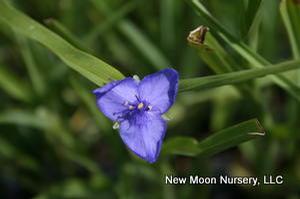Printed at http://www.newmoonnursery.com/index.cfm/
Tradescantia ohiensis
Ohio spiderwort
Native to North America
FIRST IMPRESSIONS: Tradescantia ohiensis a robust perennial with multiple stems bearing narrow pointed blue-green leaves. In late spring, foliage is topped by small clusters of violet florets. This unique wildflower thrives in prairies, on sunny roadsides or in sunny gardens with average soil.
HABITAT & HARDINESS: Tradescantia ohiensis is native to Ontario, south to Maine and Florida and west to Minnesota, Nebraska, Kansas, Oklahoma and Texas.
This spiderwort is very adaptable and is indigenous to moist to mesic Blackland prairies, sandy Black Oak and Bur Oak Savannas, thickets, edges of woods, moist meadows, limestone glades, disturbed ditches, sandy roadsides and right-of ways.
Plants are hardy in USDA Zones 3-9.
PLANT DESCRIPTION: Tradescantia ohiensis grows in beefy clumps that originate from thick fleshy roots and rhizomes.
Stems are green and glaucous with alternate linear foliage. Each blade is entire with a pointed tip and is up to 15” long and 1” across. Leaf bases wrap around the stems. The blades have parallel veins and tend to droop toward the tip.
For about six weeks in late spring and early summer plants bear small tightly clustered terminal cymes. The 1” florets are violet to blue with three rounded petals and six bright yellow anthers supported by feathery violet filaments.
The lovely blooms are ephemeral – opening for only a day and only in the morning. The florets close during bright sunny afternoons and a new crop appears the next day.
After flowering, seed capsules split into 3 segments releasing small brown seed.
Plants are 2-3’ tall with a 1-2’ spread.
CULTURAL & MAINTENANCE NEEDS: Tradescantia ohiensis grows best in sunny or partly sunny sites. Plants tolerate part shade but may not bloom well.
This versatile wildflower prospers in moist or dry loamy, clay, gravelly, sandy acidic soils or average garden soil. Plants also tolerates alkaline soils and drought
This species is fairly pest resistant but is occasionally nibbled by deer and other herbivores.
In warm regions, spiderworts go dormant during the summer. It is wise to pair them with late blooming perennials that can fill in the gaps.
LANDSCAPE USES: Tradescantia ohiensis is appropriate for Perennial Borders, Meadows or Rock Gardens. Small Groups or Masses of plants offer Attractive Foliage, Showy Flowers and provide Erosion Control. This species is a valuable component of Cottage Gardens, Deer Resistant Plantings, Low Maintenance Plantings, Perennial Borders, Rain Gardens, Wetlands and Wildlife Gardens.
COMPANION & UNDERSTUDY PLANTS: Tradescantia ohiensis mingles cheerfully with Asclepias incarnata, Chrysogonum virginianum, Eupatorium perfoliatum, Penstemon digitalis, Rudbekia hirta and Schizachyrium scoparium.
Tradescantia ohiensis ‘Mrs. Loewer’ could be substituted in some garden situations.
TRIVIA: Flowers are pollinated by bumblebees. Other bees, flies and butterflies visit the flowers as well. Deer, Rabbits, Box Turtles, and some livestock nibble the foliage.
Tradescantia ohiensis is likely to be taller, spindly and more tolerant of hot sunny sites than other Tradescantia spp. Compared to the similar T. virginiana, this species has little pubescence on the sepals and grayish blue tinged leaves.
For years, Tradescantia spp. have been touted as indicator plants for radiation leaks or as a sort of botanical watchdog for nuclear power plants. It has recently been confirmed that stamen hairs of Tradescantia ohiensis (KU 7 clone) do indeed change color when exposed to radiation in the lab.
Height:
2-4 ftSpread:
2-3 ftUSDA Hardiness Zone:
5-8Bloom Color:
Light BlueTradescantia ohiensis Characteristics
Attracts Wildlife
- Butterflies
- Pollinators
Attributes
- Rain Garden
- Favorite
- East-Coast Native
- Cut Flower
- Clay Soil
- Bog
- Naturalizing
- Long Blooming
Exposure
- Partial Shade to Full Sun
Flowering Months
- September
- August
- July
- June
Foliage Color
- Blue-Green
Growth Rate
- Medium
Juglans nigra Tolerance (Black Walnut)
- Yes
Season of Interest (Foliage)
- Summer
- Spring
Soil Moisture Preference
- Moist to Wet
Interesting Notes:
For more information on this plant, visit the USDA PLANTS Database: http://plants.usda.gov/java/profile?symbol=TROH

